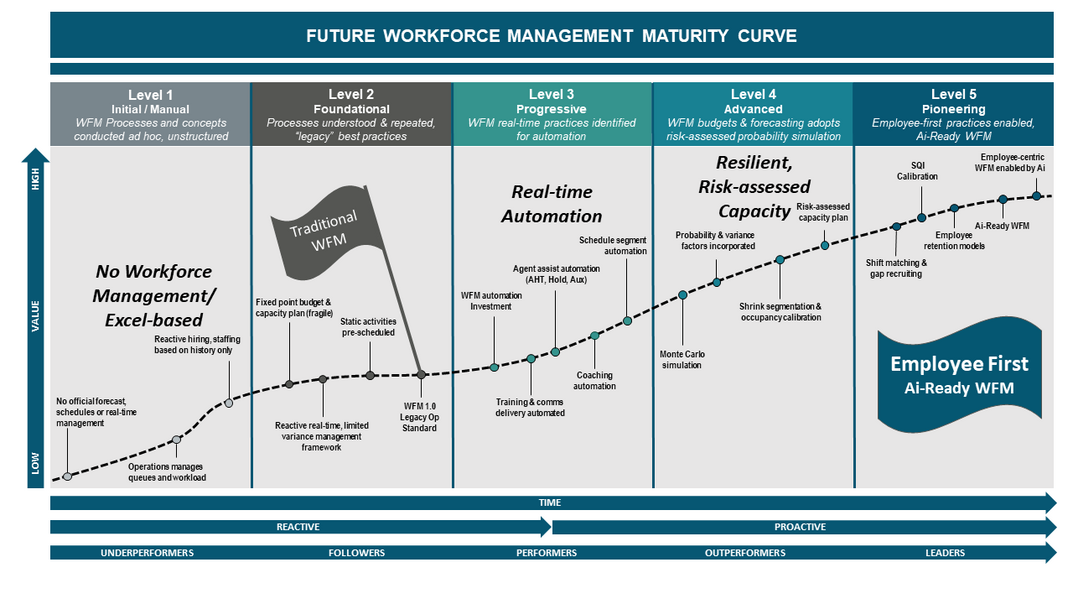Difference between revisions of "WFM Maturity Curve"
(Created page with "==== Introduction ==== We leverage a maturity curve model to support the framework for the next generation of workforce management. This model has been updated in 2023 to refl...") |
(No difference)
|
Latest revision as of 12:43, 23 October 2024
Contents
[hide]Introduction
We leverage a maturity curve model to support the framework for the next generation of workforce management. This model has been updated in 2023 to reflect the availability of technologies and approaches which can be leveraged to support delivering the WFM framework in a new light:
- where employees are prioritized first and how automation technologies can be leveraged to benefit employees.
- where new methods for creating more resilient capacity plans incorporate simulation and variance probabilities into our processes.
- where strategies are leveraging real-time automation to address variations to our plan.
- and where WFM teams leverage technology and automation to impact employee satisfaction and retention.
Leveraging a maturity curve allows the organization to assess its current position and plan for future enhancements to advance up the maturity curve.
The curve is segmented into five areas, with the value for an organization increasing advance up the curve:
Level 1 - Initial / Manual
Level 1 in the maturity curve represents organizations that are either new to WFM or have limited investments in the people, process, and technology required to support contact center organizations effectively. There may be no official forecast, schedules, or real-time management. Operations may manage queues and distribute workload (vs. having a dedicated WFM team). Hiring is done reactively when service levels begin to deteriorate. In level 1, there is no investment in WFM software to create forecasts and schedules. In level 1, customer experience likely suffers, and when customer service (service level) is met, the expenses on the business itself are likely high.
Level 2 - Foundational (Legacy WFM Practices)
Level 2 in the maturity curve is where a significant portion of contact centers reside in 2023; these companies have invested in the people, processes, and traditional WFM software technology to balance supply and demand, service level, and expense. Legacy practices represent several decades of work that seeks to get forecasts accurate, match those forecasts with "just the right staff," and react to real-time variance. Legacy WFM emphasizes pre-planning and leverages the software available to attempt to get staffing "just right." While getting the staff level ahead of time "just right" would seem logical, one negative outcome is that the plan becomes "fragile" or likely to break when variance is introduced. And since WFM teams cannot react to real-time variance, contact centers and WFM teams spend significant time responding to variance.
Level 2 may have extensively matured the people, processes, and use of the traditional WFM software compared to Level 1. However, it still needs to be improved because of the problems introduced by fragile capacity plans and the lack of an effective way to continuously manage intraday variance across the entire ecosystem.
Level 3 - Progressive
Level 3 in the maturity curve introduces the foundational automation components required to address limitations in addressing intraday variance. This level leverages technology beyond the core ACD and WFM software to dynamically tune variance to plan. In leveraging intraday automation, WFM's focus begins to provide the proper attention to real-time and re-balance efforts to achieve goals. Level 3 allows WFM to re-think all three components of WFM: Real-time management, scheduling, and forecasting. By introducing intraday automation, WFM teams can begin re-writing legacy processes that were once completed in the pre-planning stage. Real-time automation enables a critical change in the approach to forecasting and enables level 4, the introduction of simulation, and resilient risk-assessed capacity plans.
Level 4 - Advanced
Level 4 in the maturity curve re-examines the traditional approach to building contact center budgets and seeks to establish resilient, risk-assessed capacity plans. This level introduces Monte Carlo simulation, incorporates probability & variance factors, segments shrinkage inputs, calibrates occupancy, and presents leadership with a range of staffing outcomes. This range of outcomes acknowledges there is natural variance to all values leveraged to forecast and staff contact centers and advocates for incorporating probability to deliver a far more resilient staffing plan.
While level 4 can be modeled without real-time automation described in level 3, introducing resilient capacity plans requires automation to optimize staffing at an interval level. The maturity curve's levels 3, 4, and 5 follow a logical path where each advancement builds on the proceeding level.
Level 5 - Pioneering
Level 5 in the maturity curve leverages automation, simulation, and risk-assessed capacity plans to reposition WFM, putting employees first and solving the legacy problem of high employee turnover. Organizations at Level 5 represent the pinnacle of WFM maturity and are best positioned to embrace both changes and challenges introduced with new AI technologies. By prioritizing the well-being and satisfaction of their employees, they aim to address the long-standing challenge of high turnover rates in contact centers. Processes such as shift bids, schedule design, and employee retention models are innovatively redesigned to foster a positive work environment. Their capacity plans are not just resilient but are also tailored to accommodate employee-first policies. Organizations at this level have successfully merged efficiency, customer satisfaction, and employee well-being into their WFM strategy.
